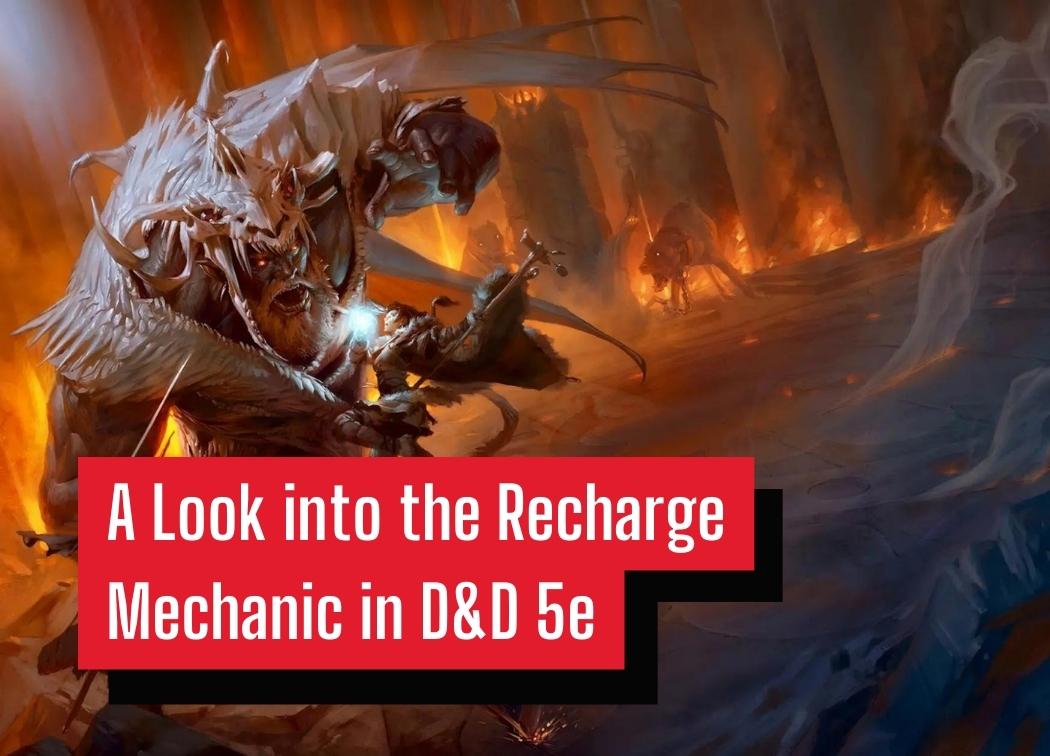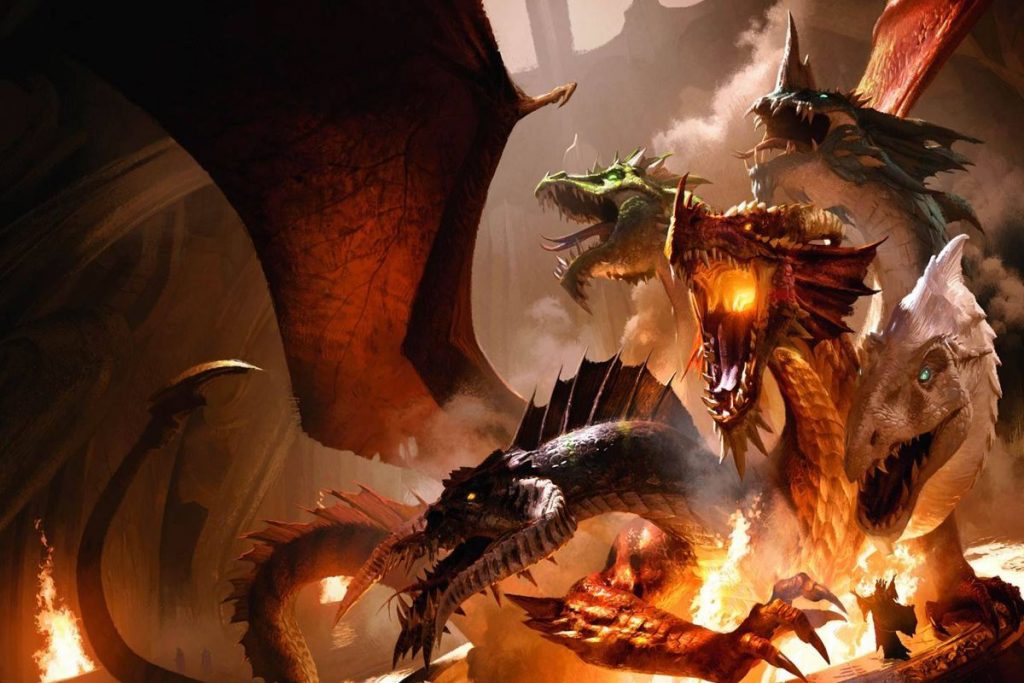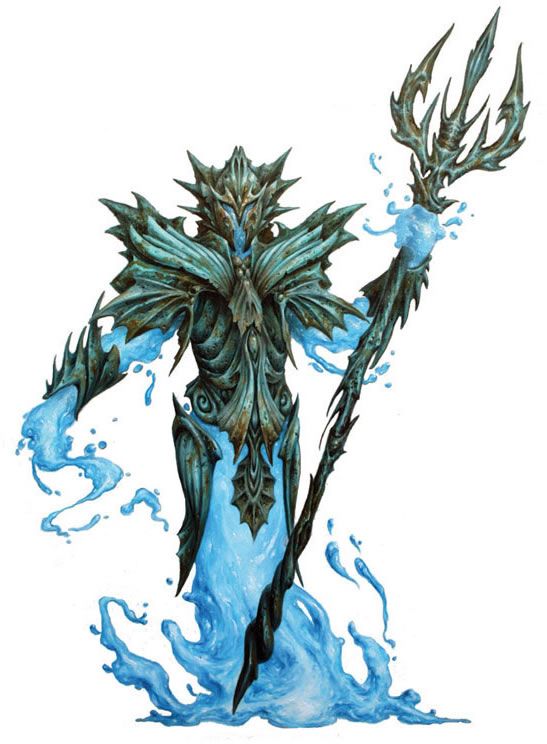A Look into the Recharge Mechanic in D&D 5e

I’ve been using a lot of elemental myrmidons in my homebrew campaign lately. They’re quite a lot of fun. They can dish out a truckload of damage and they have respectable defenses to give my level 13 party a challenge. However, the coolest part about their statblock has to be their recharge action.
Each of the elemental myrmidons has an action that either allows them to make a single, extremely powerful attack or an enhanced version of their Multiattack. The catch, of course, is that these actions take a few rounds to recharge after they have been used.
This effectively gives elemental myrmidons a hefty opening attack to potentially dish-out some terrifying damage against the party. Other creatures, such as dragons, have an AoE damage attack as a rechargeable action.
We’ve had at least one creature featured so far in our D&D Monster Monday series that has an ability with this mechanic. As you can see, it’s tied to the creature’s most powerful Action which is par for the course for how recharge actions are designed.
Let’s take a deeper look into how the recharge mechanic works in D&D 5e and how we can use it for our homebrewed encounters and creatures!

What is the Recharge Mechanic?
Recharge isn’t a difficult concept. It simply means that once the action has been taken, it may not be able to be used during the next turn or turns. I say “may” because recharge in D&D 5e is tied to a 1d6 roll.
Each action that has a recharge rate specifies within its description how often it can recharge. This is indicated as Recharge X-Y with X-Y being a range of values on a 1d6 roll.
After you use an action with recharge you’ll need to make this 1d6 roll at the start of the creature’s turn. If the result of the roll is within the X-Y range of the action’s recharge, the action can be used again.
All actions with the recharge mechanic will be recharged on a short or long rest, but some actions specify this instead of the X-Y range. This is self-explanatory, so I’m solely going to mention the fact that it exists and we’ll carry on from there.
You can find the official description for the recharge mechanic on page 11 of the Monster Manual.
Determining an Action’s Recharge Rate
As with everything that requires a dice roll in D&D, the recharge rate of an action is tied heavily to probability. If we are designing a creature or slapping on a new action to a pre-existing statblock, we’re going to need to figure out how we can balance the action in question.
Actions that require any sort of recharge are going to understandably be powerful attacks or crowd control actions for the creature to use. These actions will generally hit above the creature’s respective CR or give them a desirable attack option, for example, dragons gaining a spike of AoE damage with their breath weapon.
With this in mind, designing how the action works is not difficult. It just needs to be a powerful, desirable action that’s better than the creature’s Multiattack. However, the rate at which the action recharges is what we need to contemplate.
Generally, most rechargeable actions have a rate of 5-6 or 6 meaning that they’ll recharge 1/3 (33.3%) or 1/6 (16.6%) of the time. However, your recharge rate can be whatever you’d like it to be.
The rule of thumb is that the more powerful the action, the lower the recharge rate. Makes sense, right?
The Issues with the Recharge Mechanic
Unreliable for Short Combat Encounters
I find most of my combat encounters last around 3-5 rounds on average with most random encounters or “trash mobs” leaning closer to 3 rounds. This means that an action with a recharge rate of 5-6 only has an 11% chance of being used twice in the first 3 rounds if you use the action on round 1 of combat.
This means that actions with a recharge rate of 5-6 or 6 are most likely going to be used once in a short combat encounter. Essentially, a creature’s statblock shouldn’t bank on being able to use its rechargeable action regularly.
With that in mind, if you’re expecting the encounter to be finished quickly, use the creature’s rechargeable action in the most opportune way possible. Chances are, you won’t get a second shot at using it if you whiff it completely!
Leaves a Flavorful Action’s Usage Up to Chance
The recharge mechanic is great for creatures like the elemental myrmidons that I previously mentioned. And while it’s balanced, it does feel as if you miss out on some flavor in examples such as a dragon’s breath weapon attack. Sure, they shouldn’t be able to douse your party in 18d6 fire damage every round, but a compromise would be nice!
Thankfully, ThinkDM wrote up a solution to this issue to make breath weapon attacks both balanced and more frequent by giving the dragon a recharging pool of damage dice that they can draw from whenever they use their breath weapon.
Still though, if we’re playing by the rules as they’re written, the recharge mechanic can make creatures with breath weapons or other burst damage feel very “feast or famine” depending on the probability of recharging their action on each turn.
Dragons are plenty deadly without their breath weapon on every turn, but it would be nice to have a more reliable option to keep the party on their toes!

Use Cases for the Recharge Mechanic
Keep in mind that there are plenty of other ways to utilize the recharge mechanic. For example, you could tie some form of strong crowd control or utility to a recharge rate.
However, most of the time I use the recharge mechanic it’s for burst damage or enhancing a creature’s Multiattack to deal extra damage. I find that this is particularly useful for dealing additional damage in a boss encounter. Especially when the action economy is in the players’ favor!
Heavy-Hitting Openers
You’ve got one shot, one opportunity. Well, if that’s the case, you should take it early and hope for the best!
Sometimes you know that your creatures won’t survive very long. In that case, it’s best to drain the party’s resources and make the encounters that follow just a bit more difficult for them. Unleash all of your special actions and high-damaging spells and make them pay.
This was how I used the elemental myrmidon that I mentioned earlier. I knew that my party would probably burst them down in 3 or 4 rounds so it would be best to unleash their single burst attack or their enhanced Multiattack and hope for the best. If I get lucky then I can use those actions again, but if not, the damage has been done at least.
Large, Randomized Burst Damage
You should always use legendary actions and/or lair actions for important encounters where the party outnumbers the enemy. They help give the creature(s) additional damage or crowd control that they can use while bolstering their action economy to get close to or match the party’s action economy.
However, you can also use rechargeable actions to make your boss creature that much more terrifying to fight against. Give a boss creature a hefty single-target, cleave, or AoE damage attack and I guarantee that the party will take them seriously. Especially if they can’t judge exactly when the action will be used again.
This is effectively how a dragon’s breath attack is used. The party doesn’t know exactly when they’ll be hit by it next, so they need to anticipate it and plan their tactics accordingly as if it was always up. Sure, it only has a 1/3 chance of being recharged any given round, but that’s enough to be treated seriously.
Large amounts of burst damage, AoE or otherwise, is an excellent way to put a party of cocky adventurers into fight or flight mode!
Special Actions that Hit Above the Creature’s CR
I can’t in good faith say that CR is a super reliable way to judge a creature’s strength. We don’t even have WotC’s formula for determining it so it’s difficult to know how reliable it truly is.
However, it’s one of the few ways we can easily make comparisons between creatures of a similar CR.
What we can say certainly though is that CR has a range. What I mean by this is that not every creature at CR 5 can deal exactly 45 damage per round. There’s a threshold for each CR with regards to a creature’s ability to provide crowd control, supply utility, deal damage, and survive incoming attacks.
Actions with a low recharge rate such as 5-6 or 6 can, theoretically, be used to let a creature temporarily surpass their CR’s expectations of doing one of those things for a single action. For example, a dragon’s breath attack temporarily bolsters its damage-dealing ability beyond that of its normal capabilities.
This is balanced because since the action is on such a low recharge rate, the probability of it being used regularly is highly unlikely.
Conclusions
The recharge mechanic gives designers and homebrewers an avenue towards giving a creature an action that hits above their CR or just does a lot of AoE damage/crowd control. Actions that need to be recharged will be almost always used on cooldown, but the recharge rate is what balances these actions more than anything.
When designing an action that you think requires a recharge to keep it balanced, consider how powerful the action is. Truly exceptional actions should be closer to the “recharge on 6” range while actions that are just slightly more powerful than average can be closer to the “recharge 3-6” range.
While it’s certainly not the most consistent way to balance powerful attacks, recharge does its job well enough for a game that is immersed in probability. Consider giving your next BBEG a single-target burst damage or AoE action with recharge to randomly liven up your group’s next boss fight!

A question regarding the recharge mechanic… If a creature hits its recharge ability and uses it, does that consume their action for the turn, or can they then make a normal attack?
A rechargeable action still requires the use of an action for the turn unless stated otherwise.